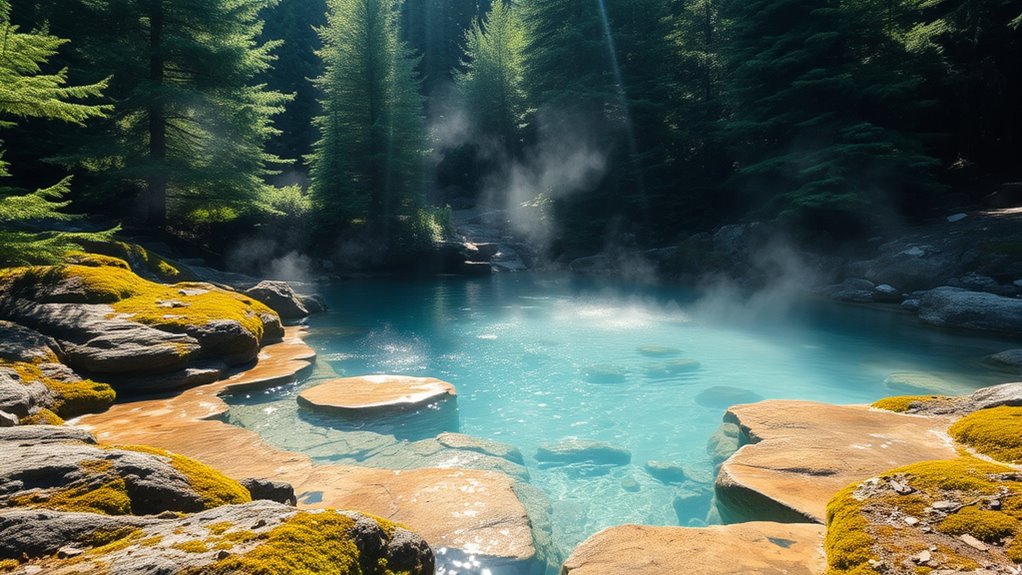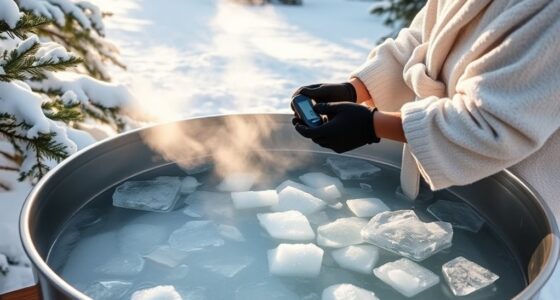Natural cold plunge features offer eco-friendly benefits by reducing energy use through lower heating needs and integrating renewable energy sources like solar power. They conserve water by relying on natural filtration methods and recycling water, which minimizes waste and dependence on municipal supplies. Additionally, these systems limit chemical treatments, promoting healthier water quality without harming the environment. If you want to discover more about how these features support sustainability efforts, keep exploring the benefits they provide.
Key Takeaways
- Utilizes natural water sources and recycling, reducing dependence on municipal water and lowering resource consumption.
- Operates at lower temperatures and integrates renewable energy, decreasing energy use and greenhouse gas emissions.
- Employs chemical-free natural filtration and biofilters, minimizing environmental impact and chemical waste.
- Incorporates rainwater harvesting, conserving water and supporting sustainable resource management.
- Requires less infrastructure and energy, leading to reduced operational costs and a smaller ecological footprint.

Natural cold plunge features offer a sustainable alternative to traditional heated pools, providing health benefits while minimizing environmental impact. Unlike conventional pools that rely heavily on chemical treatments and energy-intensive heating systems, cold plunge setups often prioritize sustainable water use and efficient energy management. By implementing smart water circulation systems, you can considerably reduce water waste, recycling and filtering water more effectively. This not only conserves a precious resource but also lowers the environmental footprint associated with frequent water replacement. Additionally, many natural cold plunge designs incorporate features like natural filtration or plant-based biofilters, which further reduce the need for chemical treatments and enhance water sustainability.
One of the key advantages of these features is their ability to integrate renewable energy sources. Many outdoor cold plunge systems are designed to harness solar power through photovoltaic panels or solar thermal collectors. This renewable energy integration cuts down reliance on fossil fuels, making the entire setup more eco-friendly. By powering pumps, filtration systems, and lighting with clean energy, you reduce greenhouse gas emissions, contributing to a healthier planet. This setup also means you can enjoy your cold plunge without the guilt of excessive energy consumption, aligning your wellness routine with sustainable living principles.
Natural cold plunge features often require less infrastructure and energy compared to heated pools, which depend on electric or gas heaters. Since these pools operate at lower temperatures, they demand less heating energy, further reducing emissions and operational costs. Additionally, their design encourages a more passive approach to water management, meaning less energy is needed for circulation and maintenance. When you choose a natural cold plunge, you’re supporting a more sustainable model of recreation that emphasizes eco-conscious design and resource efficiency.
Furthermore, many natural cold plunge options incorporate features like rainwater harvesting or natural water sources, minimizing dependence on municipal water supplies. This approach not only conserves water but also reduces the energy required to treat and transport water. When you opt for these features, you’re actively participating in water conservation efforts, which are vital in regions facing water scarcity. water conservation is a key aspect of sustainable living, and choosing natural cold plunge features supports this essential goal.
Frequently Asked Questions
How Do Natural Cold Plunge Features Impact Local Water Conservation Efforts?
Natural cold plunge features can positively impact your local water conservation efforts by promoting water reuse and reducing your ecological footprint. When you choose natural systems, you often use less water compared to traditional methods, as they rely on natural sources and minimal filtration. This not only conserves water but also minimizes pollution and energy use, helping you lower your overall ecological impact while enjoying the benefits of a invigorating cold plunge.
Are Natural Cold Plunge Installations Sustainable in Different Climate Zones?
Natural cold plunge installations are like chameleons, adapting to different climates. In mild zones, they thrive with minimal challenges, but in extreme weather, installation challenges increase, requiring specialized insulation or heating. Climate adaptability varies, so you’ll need to take into account local temperature fluctuations and water sources. While sustainable in many zones, careful planning ensures your cold plunge functions efficiently, regardless of climate, making it a smart, eco-friendly choice.
What Materials Are Eco-Friendly for Constructing Natural Cold Plunge Features?
You should choose eco-friendly materials like recyclable plastics, sustainably sourced wood, and biodegradable components for constructing natural cold plunge features. These materials help reduce environmental impact and promote sustainability. Recyclable materials can be repurposed after use, while biodegradable components break down naturally, minimizing waste. By selecting these options, you support eco-conscious building practices and create a cold plunge that aligns with environmental preservation efforts.
How Can Natural Cold Plunge Features Reduce Overall Energy Consumption?
Think of a natural cold plunge as a invigorating gust for your energy bills. By harnessing passive cooling and natural insulation, you boost energy efficiency and cut back on power use. This setup acts like a wise steward, conserving resources and reducing your carbon footprint. Embracing these features turns your wellness space into a model of sustainability, proving that relaxation and resource conservation go hand in hand.
Do Natural Cold Plunge Features Contribute to Supporting Local Ecosystems?
Yes, natural cold plunge features support local ecosystems by preserving wildlife habitats and maintaining ecosystem balance. By using natural water sources and eco-friendly design, you reduce chemical runoff and habitat disruption, allowing native species to thrive. This sustainable approach encourages biodiversity, helps protect sensitive habitats, and ensures that your cold plunge activity benefits the environment rather than harming it. Supporting local ecosystems becomes easier with environmentally conscious choices like these.
Conclusion
By embracing natural cold plunge features, you’re not just enhancing your well-being—you’re making a subtle yet impactful choice for the environment. Imagine the possibilities when more people adopt these eco-friendly options; the ripple effect could be extraordinary. But what if this quiet revolution is just beginning? The true potential of these sustainable features remains hidden, waiting for you to access it. Are you ready to take the first step toward a greener, healthier future?









